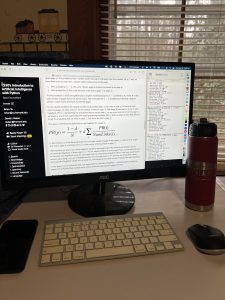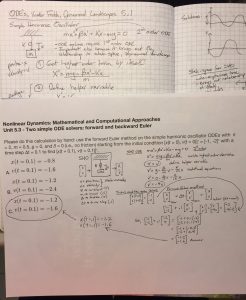Math has a funny way of making many of us nervous. Even though I was a math and computer science major as an undergrad, sometimes math gives me anxiety. For some, just hearing the word “math” triggers a sense of dread, similar to how the Cold War tensions in Dr. Strangelove made the world sit on edge. Yet, much like in the film, where panic and fear were driven by misunderstanding and overreaction, our collective anxiety around math often stems from myths and misconceptions. For the purposes of this article, I’m going to use the terms math, numbers, data, and analytics somewhat interchangeably, as they are all closely interrelated. Whether we’re talking about solving equations or interpreting analytics, it all comes down to understanding and effectively using the information available to us.
“We have to stop framing mathematics as a subject that’s only for the elite few and recognize that it’s something everyone can understand and appreciate.”
-Dr. Hannah Fry, contemporary mathematician, author, and professor
The 1964 classic movie Dr. Strangelove or: How I Learned to Stop Worrying and Love the Bomb is a satirical take on the Cold War, where characters grapple with irrational fears, exaggerated threats, and an inability to deal logically with their anxieties. The central message is clear: fear itself is often the greatest enemy. Math anxiety is much the same. We magnify our fears to the point where math feels like an insurmountable challenge—when in reality, it’s simply a tool, much like numbers in our daily lives. Just as the characters in the film needed to overcome their panic to make rational decisions, we need to reframe how we view math. Instead of seeing it as something to dread, we can view it as a useful skill that opens doors to problem-solving, better decision-making, and a deeper understanding of the world around us.
Besides Fear – Different Ways People Approach Math
On the other hand, there are also those who approach math with an inflated sense of confidence, even when they’re wrong. They barrel through, convinced they have the answers, and often miss the nuance and beauty of the subject. This overconfidence can be just as dangerous as anxiety—it leads to mistakes, missed opportunities for learning, and a disregard for those who struggle. As with any skill, true understanding of math requires a blend of humility and curiosity. I’ve encountered this type of overconfidence firsthand, particularly when dealing with data and analytics. One experience that stands out took place during a presentation where I was discussing marketing effectiveness.
During that presentation, I quoted a statistic about marketing effectiveness, and before I could even finish my statement, a member of the audience blurted out that I was wrong. They claimed I had the numbers backward. I politely asked them to let me finish my thought, which included a citation of my data source. They even challenged that. I acknowledged their objection and pressed forward with the presentation. While I continued to speak, I noticed they had their phone out, clearly looking up the answer. After the presentation, I saw them trying to make a quick exit toward the door. Ironically, I ran into the same person later in the day at another local event. I politely asked if they had found the answer they were looking for. The person admitted that my citation checked out, but they still didn’t agree with my assertion and would continue looking into the situation. I’m not always right, and I’ll be the first to admit that I often transpose numbers or make errors in calculations. But some people have a hard time being wrong, and their overconfidence dissuades others from engaging. It’s okay to have some healthy skepticism, but taken to an extreme, it can become misguided overconfidence that pushes people away.
Besides the people who are overly confident or scared of math, some misuse it entirely. They tend to bend statistics or numbers to fit a false narrative. Whether it’s cherry-picking data or misrepresenting statistics to make a point, this approach is dangerous, especially in marketing, where analytics play a crucial role in decision-making. Some business owners overstate the importance of metrics, treating them like the end-all, be-all, without considering the true impact or importance of what they’re looking at. For example, sometimes the misuse is misguided, but not necessarily harmful, like in the case of “vanity metrics.” It’s very common for businesses, particularly small businesses and nonprofits, to be enamored with social media likes on specific posts without looking at more important analytics that indicate sustainable marketing effectiveness. Vanity metrics can mislead organizations into wasting resources to “beat the algorithms” in a false quest to become “viral.” Taken to an extreme, a disregard for accuracy and nuance in numbers can foster a culture where truth becomes malleable. Math, especially in the form of analytics, is meant to clarify and inform, not confuse or mislead. It’s crucial that we respect its integrity and view it as a tool to guide strategy rather than a weapon to manipulate outcomes. Always check the source of any numbers or data provided, and consider the relevant importance and merit of the message they convey.
On the other hand, some people ignore math altogether, choosing to rely on gut instinct instead of data-driven insights. This is particularly harmful in marketing, where analytics can provide critical feedback. I can’t tell you how many excellent marketing campaigns I’ve seen cut short because the business executive refused to consider the facts and didn’t understand the difference between marketing and sales. Last summer, I was talking with one of our retail clients, who told me they were cutting their marketing budget because they didn’t feel like it was generating sales. I politely reminded them that marketing is not sales. The primary goal of marketing is promotion and awareness. All of the metrics were showing that marketing was effective—the website traffic was at record levels, and foot traffic in their retail location was as high as it had been all year. If you have a lot of people coming to your website and into your store, but they’re not buying, that’s a sales problem, not a marketing problem. The client said they didn’t care what the numbers were showing and that they were going to cut marketing anyway to focus on sales. Ignoring the data means ignoring reality and ultimately undermining long-term success. Since that time, my now former client has basically disappeared from online searches, and sales have dropped even further.
In today’s data-driven society, we face immense pressure to reduce ourselves to numbers—grades, credit scores, social media metrics, productivity stats. But while math and numbers count, people matter more. We are more than a sum of data points, and it’s time to reclaim the wonder of math as something to be explored, not feared or blindly followed. When we remove the pressure to be defined by numbers and focus instead on how math can help us understand the world around us, we open the door to a much more fulfilling relationship with it.
Why People Fear Math

Exploring the math and Python programming code behind Google’s Page Rank Algorithm during Harvard CS50’s Introduction to AI with Python online class. Photo/Joe Domaleski
Math anxiety doesn’t usually develop overnight. It’s often rooted in early experiences, where students feel pressure to perform quickly or fear judgment for wrong answers. Math is a cornerstone of education, and how it’s taught can shape a student’s entire perspective on learning. Teachers play an essential role in helping students build confidence and curiosity in math, encouraging them to approach problems with a growth mindset. When students feel supported rather than judged, math becomes less intimidating and more like a tool they can use throughout their lives. That’s why it’s critical to invest in education as a community—by supporting teachers and creating environments where students can thrive, we give future generations the chance to see math as an opportunity, not an obstacle. Much like the characters in Dr. Strangelove, who are driven by a sense of impending doom, people often feel an irrational fear toward math due to several common factors:
- Perfectionism: Many people associate math with the need for exact answers and fear making mistakes. This perfectionist mindset makes even small errors feel disastrous, leading to anxiety.
- Early Failures: Negative experiences with math in school, such as bad grades, often leave lasting impressions. These experiences create a belief that math is an innate skill, and if you’re not “good at it” early on, you never will be.
- Time Pressure: In school, math is often taught with an emphasis on speed, through timed tests or quizzes. This creates the false belief that math ability is tied to how quickly you can solve problems, causing anxiety when people feel they’re not fast enough.
- Cultural Myths: Society perpetuates the idea that some people are naturally “math people” while others are not. This discourages individuals from seeing math as a skill they can develop with effort.
- Fear of Judgment: Many adults avoid math out of fear of being judged for not having strong math skills, particularly in areas like finances or workplace calculations, which can lead to embarrassment.
In Dr. Strangelove, General Ripper famously says, “War is too important to be left to the politicians.” In the same way, math is too important to be left to fear. Numbers play a big part in everything we do—from managing our money and health to navigating today’s data-driven economy. Every day, decisions get made based on numbers, whether it’s in business, healthcare, or public policy. But too often, math anxiety stops people from embracing how useful numbers can be. Math is practical; it helps solve real-world problems, make better choices, and understand how things work. Whether you’re working on your budget, growing your business, or making decisions about your health, math has a role to play. When we avoid it, we’re passing up opportunities to improve our lives. It’s time to stop treating math like something to fear and start seeing it as a tool that can make a real difference.
Overcoming the Fear of Math
Just as the characters in Dr. Strangelove needed to abandon their irrational fears and adopt a more logical mindset, adults can learn to reframe their relationship with math. The good news is, it’s easier than you think to make small changes that can dramatically reduce math anxiety. Often, the fear of math is tied more to our perception of it than the actual complexity of the subject itself. By making simple adjustments—such as shifting our mindset or starting with basic tasks—we can change the way we approach math and build confidence along the way. Math doesn’t have to be intimidating or stressful. In fact, with the right approach, it can become a useful and even enjoyable part of your daily routine. Here are some practical strategies to start overcoming math anxiety:

Keeping my brain sharp by using a little calculus and linear algebra to solve ordinary differential equations for the SFI Nonlinear Dynamics course. Photo/Joe Domaleski
- Shift Your Mindset: Recognize that mistakes are part of learning. Math isn’t about getting everything right on the first try; it’s about working through problems and learning from the process. Just like in Dr. Strangelove, where the characters fail by holding onto fear, we must acknowledge that math success is about persistence, not perfection.
- Start Small and Slow Down: If you feel overwhelmed by math, begin with small, manageable tasks and take your time. There’s no rush. One of the biggest causes of math anxiety is the pressure to work fast. Slow down and give yourself the space to really understand what you’re doing. Try applying simple math in everyday scenarios, like budgeting or cooking, to ease your way back into it without feeling overwhelmed.
- Get Curious: Instead of focusing on math’s difficulty, allow yourself to be curious. Ask why certain rules or analytics work the way they do. In Dr. Strangelove, the absurdity unfolds because the characters fail to ask the right questions. Curiosity leads to understanding, and that understanding can unlock a greater sense of control over numbers.
- Find Real-Life Applications: Math becomes much less intimidating when it’s tied to practical, real-world situations. Whether you’re calculating a tip at a restaurant or setting financial goals, applying math to daily life makes it more relatable and helps dissolve the abstract fear surrounding it.
- Embrace Lifelong Learning: It’s never too late to learn math. I’m studying advanced math right now in middle age. Many adults think their window for learning has closed, but that’s far from the truth. Much like the characters in Dr. Strangelove, who cling to outdated thinking, overcoming math anxiety requires being open to learning at any stage of life. The willingness to grow and adapt is key.
Loving the Math
In Dr. Strangelove, the fear of nuclear annihilation is portrayed as absurdly overblown, just as math anxiety is often exaggerated in our minds. We tend to make math seem more intimidating than it really is. But when we stop worrying about being perfect and start embracing math as a manageable, even enjoyable challenge, we learn to “love the math.” Math is a tool, not a test of our intelligence or worth. Ignore people who say or act otherwise. “Math bullies” are often masking some other form of insecurity. By shifting our focus from getting everything right to simply understanding how math works, we can unlock opportunities both personally and professionally.

Why Machines Learn – The Elegant Math Behind Modern AI by Anil Ananthaswamy is a new book that explains the importance of math in modern AI. Photo/Joe Domaleski
The key is changing how we approach it. Math doesn’t have to be something we rush through or stress over. Slowing down and taking time to truly understand the numbers makes a huge difference. When we approach math with curiosity, it stops feeling abstract and starts becoming more practical. Simple tasks like budgeting, measuring for a recipe, or tracking progress toward a goal show us that math is a part of everyday life. It’s less about solving everything perfectly and more about applying what we know to real-world situations at home or work.
We often turn math into a battle in our own minds, but it doesn’t have to be that way. As President Merkin Muffley famously says in Dr. Strangelove, “Gentlemen, you can’t fight in here! This is the War Room!” Similarly, there’s no need to fight math. When we stop seeing it as something to conquer and start treating it as a tool to solve problems, it becomes far less intimidating. With the right mindset and a little patience, math can actually make things easier. It’s about progress, not perfection. When we let go of the fear and approach math with a willingness to learn, we can stop worrying and start using math to improve our lives.
Final Thoughts
You don’t have to become a math genius to overcome math anxiety. Yes, there will always be people who can do math calculations in their head that you can’t do, much like an athlete might be able to accomplish an athletic feat you can’t do. That’s okay and normal. Learning to reduce anxiety and love numbers is about taking small, steady steps to change the way you think about math. Instead of seeing it as something to fear or rush through, math can be approached with curiosity and patience. By starting small, slowing down, and applying math to real-life situations, you can build confidence over time. You probably won’t get everything right the first time and that’s fine. Reducing the fear of math is about progress and persistence. When we embrace math as a tool for problem-solving, rather than something to be afraid of, we unlock its potential to make our lives easier.
Give yourself the space to learn and explore—you might just find that you can, in fact, learn to love the math. So, what’s one small change you can make today to improve your relationship with math? It could be something as simple as calculating the tip at dinner without using your phone, setting up a basic budget for the week, or trying out a math puzzle or app in a low-pressure environment. These small, real-life steps can help you rebuild your confidence and shift your mindset toward seeing math as a useful skill, not a source of stress.
[Joe Domaleski, a Fayette County resident for 25+ years, is the owner of Country Fried Creative – an award-winning digital marketing agency located in Peachtree City. His company was the Fayette Chamber’s 2021 Small Business of the Year. Joe is a husband, father of three grown children, and proud Army veteran. He has an MBA from Georgia State University and enjoys sharing his perspectives drawing from thirty years of business leadership experience. Joe is a recipient of the Peachtree City Rotary Club Business Leader of the Year Award for 2024. Sign up for the Country Fried Creative newsletter to get marketing and business articles directly in your inbox. You can connect with Joe directly on LinkedIn or follow his new blog Marketing Data Science for more insights and updates.]


